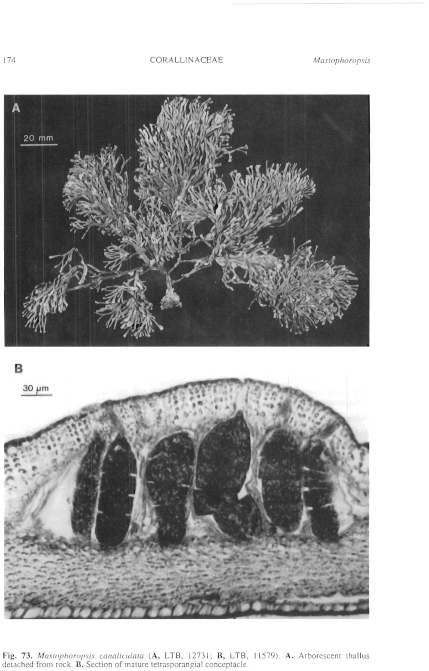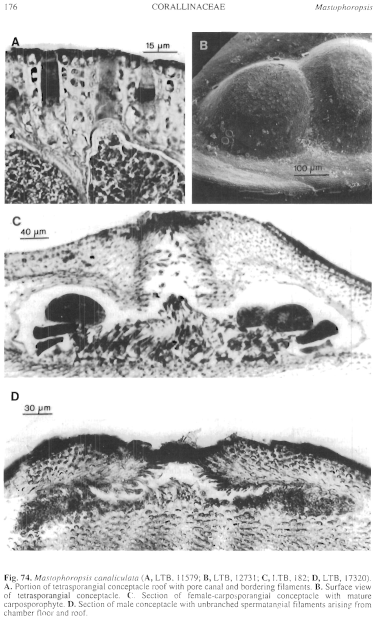|
|
|
|
|
|||||||||||
|
Electronic Flora of South Australia Species Fact Sheet
Phylum Rhodophyta – Class Florideophyceae – Order Corallinales – Family Corallinaceae – Subfamily Melobesioideae
Selected citations: Woelkerling 1988: 180, figs 201–213.
Synonyms
Mastophora canaliculata Harvey 1859: 310; 1863, synop.: xxx, pl. 263. Printz 1929: 47, pl. 73 figs 10–12.
Metamastophora canaliculata (Harvey) Setchell 1943: 132.
Additional references are provided by Woelkerling 1978, 1988.
Thallus normally dark pink to dull red-brown, arborescent, mostly 5–15 cm tall, attached by a basal holdfast that produces 1-several erect stipes with flattened, branched, ribbon like branches that commonly have vein like thickenings in older portions; branching mostly in one plane, pseudodichotomous to pseudopolychotomous. Structure pseudoparenchymatous with dorsiventral organisation throughout; construction monomerous, stipes and branches each consisting of a single system of branched, laterally cohering, filaments that collectively contribute to a centrally situated core and a peripheral region where portions of core filaments or their derivatives curve outwards towards the thallus surface, each filament composed of cells 3–15 µm in diameter and 5–40 µm long; epithallial cells 5–15 pm in diameter and 4–15 µm long, terminating most filaments at the thallus surface, with distal walls rounded or flattened but not flared; cell elongation occurring mainly behind actively dividing subepithallial initials that are usually as short as or shorter than their immediate inward derivatives; cells of adjacent filaments joined by cell-fusions although sometimes difficult to detect; secondary pit-connections, haustoria, and trichocytes unknown.
Reproduction: Vegetative reproduction unknown. Gametangia and carposporophytes produced in uniporate conceptacles; tetrasporangia produced in multiporate conceptacles. B i sporangia unknown.
Gametangial thalli dioecious. Carpogonial stages unknown. Mature female carposporangial conceptacle roofs protruding above surrounding thallus surface, 95–125 µm thick, usually composed of 13–17 layers of cells, conceptacle chambers 380–550 µm in diameter and 110–180 µm high. Mature carposporophytes apparently composed of an inconspicuous central fusion cell and short gonimoblast filaments bearing terminal carposporangia 30–80 µm in diameter. Spermatangial filaments unbranched, arising from the floor, walls and roof of male conceptacle chambers, mature male conceptacle roofs protruding above surrounding thallus surface, 45–100 µm thick, composed of 6–14 layers of cells; conceptacle chambers 340–450 µm in diameter and 30–75 µm high.
Tetrasporangial conceptacle roofs protruding above surrounding surface, 4–10 cells thick above the chamber, pore canals lined by cells that are similar in size and shape to other roof cells, conceptacle chambers 318–607 µm in diameter and 95–118 µm high; tetrasporangia scattered across the conceptacle chamber floor, each mature sporangium 40–63 µm in diameter and 70–135 µm long, containing zonately arranged tetraspores and possessing an apical plug that blocks a roof pore prior to spore release.
Type from Tasmania (locality not specified); lectotype in TCD (unnumbered); designated by Woelkerling (1978, p. 211); depicted in Woelkerling (1978, p. 212, fig. 1).
Selected specimens: Encounter Bay, S. Aust. (Cleland, 1932; NSW, A3337). Robe, S. Aust., drift (Womersley, 15.iv.1959; AD, A23001). Nora Creina, S. Aust., drift (Woelkerling, 20.viii.1966; LTB, 182). Three Mile Rocks, Beachport, S. Aust., drift (Woelkerling, 26.ii.1988; LTB, 15973 and 18.ii.1995; LTB, 17320). Cape Northumberland, S. Aust., 15 m deep (Turnbull, 30.ix.1975; AD, A46600). Dinghy Cove, Lady Julia Percy I. Vic., 4.5–7.5 m deep (Shepherd, 3.i.1968; AD, A32315). Warrnambool, Vic., drift (Womersley, 13.iv.1959; AD, A22916). Anglesea, Vic. (Lucas, Jan. 1900; NSW, A 3336). Waterloo Bay, Wilsons Prom., Vic., 10 m deep (Leach & Anderson, 21.x.1977; LTB, 10264) and 3–4 m deep (Leach, 3.iii.1979; LTB, 11579). Spike Bay, Clarke I., Bass Strait, Tas., 6 m deep (Leach, 28.ii.1979; LTB, 11602). Limestone Gully, S of Deep Glen Bay, Forestier Pen., Tas., 8–14 m deep (Gowlett-Holmes, 14.v.1995; AD, A64421). Ninepin Point, D'Entrecasteaux Channel, Tas., 6–7 m deep (Woelkerling, Plan & Brown, 18.ii.1983; LTB, 12731). Recherche Bay, SE Tas., 18 m deep (AIMS-NCI, Q66C, 14.ii.1991; AD, A61345). Lady Bay, Southport, Tas., 2–3 m deep (Brown & Kenchington, 14.x.1986; AD, A57655).
Distribution: Encounter Bay, S. Aust., to Waterloo Bay, Wilsons Prom., Vic. and from Tasmania.
Taxonomic notes: Mastophoropsis canaliculata is known mainly from drift specimens, but thalli attached to rock have been found in intertidal cave pools and at depths of 10 m in Victoria, 15 m in South Australia and 18 m in Tasmania. Thalli of M. canaliculata are usually easily recognised in the field from their arborescent growth form and multiporate tetrasporangial conceptacles. Only a few male thalli are known, and it is uncertain whether spermatangial filaments are simple or branched. Carposporangial thalli are uncommon, and the ontogeny of all reproductive structures requires further investigation.
References:
PRINTZ, H. (1929). M. Foslie — &lsquot;Contributions to a Monograph of the Lithothamnia&rsquot;. K. Norske Vidensk. Selsk. Skr. Museet, Trondhjem. 60 pp. 75 Plates.
SETCHELL, W.A. (1943). Mastophora and the Mastophoreae: Genus and subfamily of Corallinaceae. Proc. Nat. Acad. Sci. Washington 29, 127–135.
WOELKERLING, W.J. (1978). Mastophoropsis canaliculata (Harvey in Hooker) gen. et comb. nov. (Corallinaceae, Rhodophyta) in southern Australia. Br. phycol. J. 13, 209–225.
WOELKERLING, Wm.J. (1988). The Coralline Red Algae. [British Museum (N.H.): London.]
The Marine Benthic Flora of Southern Australia Part IIIB complete list of references.
Publication:
Womersley, H.B.S. (28 June, 1996)
The Marine Benthic Flora of Southern Australia
Rhodophyta. Part IIIB. Gracilarialse, Rhodymeniales, Corallinales and Bonnemaisoniales
Reproduced with permission from The Marine Benthic Flora of Southern Australia Part IIIB 1996, by H.B.S. Womersley. Australian Biological Resources Study, Canberra. Copyright Commonwealth of Australia.
Illustrations in Womersley Part IIIA, 1996: PLATE 3 fig. 1; FIGS 73, 74.

Plate 3 enlarge
PLATE 3
figure 1. Mastophoropsis canaliculata (AD, 64421). Photograph K.L. Gowlett-Holmes.
figure 2. Phymatolithon masonianum (AD, A64476). Photograph - K.L.Gowlett-Holmes.
figure 3. Synarthrophyton patena (AD, A64409). Photograph - K.L.Gowlett-Holmes.
figure 4. Phymatolithon repandum (LTB, 15836). Photograph - W.J. Woelkerling.

Figure 73 enlarge
Fig. 73. Mastophoropsis canaliculata (A, LTB, 12731; B, LTB, 11579). A. Arborescent thallus detached from rock. B. Section of mature tetrasporangial conceptacle.

Figure 74 enlarge
Fig. 74. Mastophoropsis canaliculata (A, LTB, 11579; B, LTB, 12731; C, LTB, 182; D, LTB, 17320). A. Portion of tetrasporangial conceptacle roof with pore canal and bordering filaments. B. Surface view of tetrasporangial conceptacle. C. Section of female-carposporangial conceptacle with mature carposporophyte. D. Section of male conceptacle with unbranched spermatangial filaments arising from chamber floor and roof.

|
Email Contact: State Herbarium of South Australia |

|